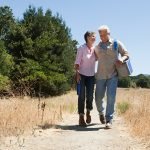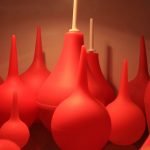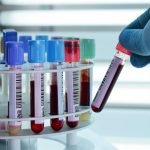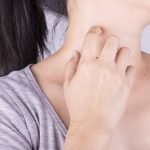Antiaging Facial Acupuncture
Jennifer Hillier, ND
A 54-year-old woman was seen at the clinic with reports of fatigue and shortness of breath on exertion following an episode of pneumonia 2 months earlier. Further questioning revealed a history of irritable bowel syndrome, the recent need for reading glasses, mild osteoarthritis of the left knee, a recent development of dry skin on her face and body, and 2 dysplastic skin lesions that had been excised 5 years earlier, with no recurrence. She reported that she had been menopausal since age 50 years. When asked at the end of the intake to state her goals for treatment, she said that she wanted to look more youthful and that her sagging jawline and dull complexion since the pneumonia were a significant barrier to her feeling healthy and vital.
In the world of antiaging and youth-obsessed culture, we as NDs can sometimes look with scorn on the requests of our patients to look younger and can minimize the influence that physical appearance has on the quality of life of our clientele. While we look at underlying pathologic conditions, root causes, and significant physical imbalances, often the true test of our skills comes in making our patients look better not only to themselves but also to their friends and families.
We should embrace the desires of our patients to maintain firm skin, have fewer wrinkles, and keep a healthy glow. These can work beautifully alongside the more critical issues of prevention and treatment of physical ailments, especially when this involves educating our clients.
As the population ages, more money is going into the antiaging industry, and facial rejuvenation acupuncture has received some attention over the years. Research has shown that acupuncture points are unique from sham points in that they have more microcirculation, a higher density of neurofibrillar networks, and increased mucopolysaccharides,1 all of which contribute to tonifying overlying structures when needled. Other researchers have noted the extensive network of collagen throughout the intercellular matrix that is stimulated with needling2 and the enhanced fibroblast activity in the immediate area of acupuncture points.3 With collagen the target of the beauty industry, this research helps to bridge the gap between what our patients see in the media and how we explain why facial acupuncture is a scientifically valid antiaging approach.
From a Traditional Chinese Medicine viewpoint, identifying the patterns of imbalance is critical to achieving lasting antiaging results. While facial acupuncture performed independent of a full constitutional workup can yield results in the short term, a complete Traditional Chinese Medicine study must be performed to practice preventive medicine and to achieve longer-lasting results. This includes tongue and pulse, pattern diagnosis, and the relevant lifestyle modification.
Case Study
In the case of the 54-year-old woman mentioned earlier, her Traditional Chinese Medicine diagnosis was lung and spleen qi deficiency with liver blood deficiency. Turning to the basics, she was prescribed a fortifying diet to build blood and qi, focusing on soups and stews made with meat bones, steamed leafy greens, and root vegetables, along with reducing sugar, dairy, and raw or processed foods. Regular meditation, rest, and daily walking were also prescribed to speed recovery.
Constitutional acupuncture was performed once per week for 10 weeks, in addition to focusing on local points that tonify and lift the jawline (CV 23, ST 9, and TW 17), points that brighten the eyes (yu yao, BL 2, and GB 14), and points that brighten the complexion (ST 9 and ST 2). To reinforce the progress throughout the week, a facial massage technique was prescribed for morning and night, along with her usual moisturizing routine. This technique involves applying light pressure at the midline and slowly massaging out to drain fluids into the lymphatics anterior to the ear. Working from the jawline to the hairline, this takes just a couple of minutes but stimulates the acupressure points, while improving circulation and exfoliation of the skin.
Grape seed extract (50 mg 3 times a day) for 3 months was prescribed to decrease tissue oxidation, build spleen qi, and address the history of dysplastic lesions. Fish oil (3 g/d) and probiotics were also prescribed for daily consumption to support skin, immune, and gut health.
After the first acupuncture session, the patient reported a feeling of tingling and tightness in the face that persisted for the rest of the day. After 4 sessions, the patient reported a change in the feel of her face, citing a firmer and more evenly hydrated surface with more even skin tone. On a scale of 1 to 10, her energy was improved from 3 to 6, and she reported that she was tolerating longer walks without any shortness of breath.
Following 8 weeks of treatment, the patient reported that her friends and family were noticing a difference in her appearance, with many asking if she had been on vacation or if she had had some work done. Clinically, her jawline was tighter, her eyebrows had lifted, and her cheekbones were more defined, along with a brighter complexion, improved skin moisture content over the entire body, and better shen.
Following the 10th treatment, the patient reported a consistent improvement in her appearance, with a parallel rise in self-esteem and quality of life. Her bowels were regular, her skin no longer required daily moisturizer application, her vision was no longer deteriorating, and she had begun to train for a 5-km run.
Follow-up care was planned. We scheduled regular facial acupuncture appointments every 4 months to maintain the effects achieved through the intensive sessions and to reassess her progress.
Three years later, the effects were still visible, and the patient was still coming for regular appointments. A death in the family and subsequent pneumonia provoked accelerated facial aging in the fourth year after treatment, so another 10-week intensive series was performed, along with counseling, immune, and gut support.
Education Goes a Long Way
Educating patients about the normal effects of aging and the limits of what facial rejuvenation can achieve is critical in any application of antiaging protocols. When patients are empowered to see wrinkles as a normal process that can be minimized but not eliminated, they are much more likely to perceive improvement from treatments. Using photographs of young and old persons, it is easy to lead patients to realize that it is not the absence of wrinkles but the presence of a bright complexion, alert eyes, and well-perfused hydrated skin that imparts an air of youthfulness and vitality to a face. A healthy face does not exist in the absence of a healthy body, and this can help to motivate patients to make positive changes in their diet and lifestyle, while enhancing their appearance.
Combine the basic tenets of naturopathic medicine with the specifics of the many facial rejuvenation acupuncture courses available to the profession. This can lead to improved patient outcomes, better referrals, and a stronger bottom line for your practice.
 Jennifer Hillier, ND focuses on antiaging medicine. Dr Hillier applies constitutional and topical therapies to optimize patient outcomes. She has lectured internationally, written for Elsevier, and founded a free clinic in Vancouver, British Columbia, Canada, while participating in alternative medical research nationally. Currently, Dr Hillier is an assistant professor and clinical supervisor at the Canadian College of Naturopathic Medicine (Toronto, Ontario) and enjoys an active family practice at the University of Guelph (Guelph, Ontario).
Jennifer Hillier, ND focuses on antiaging medicine. Dr Hillier applies constitutional and topical therapies to optimize patient outcomes. She has lectured internationally, written for Elsevier, and founded a free clinic in Vancouver, British Columbia, Canada, while participating in alternative medical research nationally. Currently, Dr Hillier is an assistant professor and clinical supervisor at the Canadian College of Naturopathic Medicine (Toronto, Ontario) and enjoys an active family practice at the University of Guelph (Guelph, Ontario).
References
- Ifrim-Chen F, Ifrim M. The relation between the acupoint structures and the clinical therapeutic effects [published correction appears in Ital J Anat Embryol. 2005;110(2):2 p following 123]. Ital J Anat Embryol. 2005;110(1):45-49.
- Chiang P. The significance of collagen-based network to acupuncture theory and therapy. Oriental Med J. 2007;15(6):6-9.
- Lu Y. Effects of “surrounding needling” on hydroxyproline content and ultrastructures in the dermis of aged rats [in Chinese]. Zhongguo Zhen Jiu. 2008;28(1):61-64.










